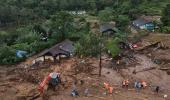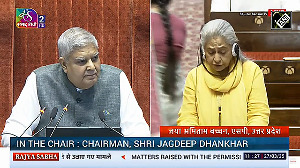Questions that the state had come to recognise over time but consistently delayed treating seriously because doing so requires an overhaul of perspective and lifestyle, notes Shyam G Menon.

In Kerala, 2024 Onam happens in the shadow of the Wayanad tragedy.
On July 30, a series of landslides triggered by intense rainfall claimed over 300 lives, left many homeless and destroyed property.
It was among Kerala's worst trysts with the workings of the planet underneath the beautiful, fragile surface humans stand on.
Notwithstanding a spate of Me-Too allegations in the Malayalam film industry shifting focus from the mishap and adding to the state's daily media din, Wayanad was still raw in collective memory as Onam came by in the first half of September.
The ninth of that month saw me at Thiruvananthapuram airport's domestic terminal. My friend and I were delighted to find an affordable cafe outside the airport, at the edge of the local car park, which sold tea and coffee at prices that didn't imitate the ridiculously over-priced innards of Indian airports.
It is another of the many tragedies we have come to call existence -- we don't bat an eyelid paying steep amounts for tea and coffee, beverages we grew up with and wired into our system as the cornerstones of a typical day.
Everything is lifestyle now, not life. Coffee had, I saw my friend off and was waiting for the electric bus to East Fort, when the annual visitor to the state from the netherworld's benign side, made his appearance.

Legend has it that the generous ruler Mahabali who presided over a fairly happy kingdom was dispatched to the netherworld after Vishnu's Vamana-avatar, promised three steps of land and having covered heaven and Earth with the first two, had to be offered the king's own head for the third.
Mahabali, though, was allowed to visit his people every year, which he does during Onam.
After landslides, heavy rains and floods spewed forth by Earth's interiors and the weather at large, beholding the people-loving Mahabali made one happy despite every landslide's shared address with Onam's treasured mythological king.
Mahabali is to Onam, what Santa Claus is to Christmas; a much-cherished mascot, a look replete with costume that some searching for livelihood undertake to play during the festival.
The airport's Mahabali had appeared on the scene, unnoticed. Having donned his dress and make-up, he slipped in from somewhere and quickly picked up a conversation with the staff working at kiosks nearby. They stood together, chatting and checking their mobile phones.
Then Mahabali commenced his day's duties, walking up and down the front of the airport, nodding to people, greeting children and generally standing out in his bright costume.
People took photographs; occasionally someone requested a selfie. The mirth he spread however hid some serious issues.
The truth is that 2024 Onam is accompanied by solid questions about Kerala's future.
Questions that the state had come to recognise over time but consistently delayed treating seriously because doing so requires an overhaul of perspective and lifestyle.

The Wayanad tragedy was yet another reminder.
Will Kerala adapt to the state's altered reality or will it, as it has done so far, push on stubbornly pursuing an agenda that satisfies the aspirations of an old, still influential feudal aspiration?
Kerala has two seasons of rain. The months of August and September, wherein Onam traditionally falls, are past the middle of a calendar year.
June and July denote the first instalment of heavy rain with portions of August too sometimes included.
Over the past decade or so, Kerala's drift to August-September and Onam therein hasn't been as confidently as before.
The old rains belonged to a weather system settled into a degree of stability and predictability.
The rains of today are the product of a warming planet; their schedule and intensity are not like before.
Adding to the stress are vagaries in weather contributed by an Arabian Sea, warmer than before.
The monsoon months now worry Kerala for the havoc they cause. People spend June and July with an eye to the heavens wondering what lay in store and where in the state, its impact would be.
Part of the apprehension is also because of lifestyle taking precedence over life; the more the assets accumulated, the greater the fear of potential loss. Who will support making the alternative choices trendy?

Fact is, despite its claims of education and awareness, Kerala never let go of its feudal heart. Old Kerala was feudal and caste-ridden.
Some course correction and a degree of social enlightenment happened courtesy the initiatives undertaken by social reformers and the rise of Left politics.
Then, years ago, the combination of Left politics and a robust trade unionism that was often perceived to be militant, denied Kerala industrialisation, sparking a scarcity of jobs.
Young Malayalees packed their bags and sought employment elsewhere, including overseas. Kerala transformed to a remittance economy.
Through all this, the yardsticks deciding success have remained feudal. It may be seen in how the newly acquired wealth was deployed.
Big houses, proliferation of vehicle ownership, mega weddings, boom in consumerism and a general assessment of human worth based on monetary status, asset accretion and corresponding social standing.
This lifestyle and the demands raised by this lifestyle (example: The desire for more highways to accommodate more vehicles) sit heavy on a state, which when viewed geographically is a narrow, long strip of land sandwiched between the sea and eco-sensitive forests and hills.
Despite pressure on land (Kerala has modestly high population overall and high density of population), the preferred pattern of habitation remains living in separately owned plots of land.
In cities, the dissection of land into multiple parcels, each of them walled and many subsequently raised higher from their old ground level or completely tiled / cemented to prevent water logging, have precipitated drainage issues just when the rains (in their specific spells) became more intense than before.
Add to it, the excesses of consumerist lifestyle -- Kerala has for some years now, been on a countdown to correction; when nature forces the state to correct what man refuses to.
Some of the narratives emerging from Kerala stun for how they embrace short term highs over long term sensibility.
For example, even as traffic in Kerala's big cities have become grossly irritating, nearly every natural calamity is followed by a media report celebrating the value of sports utility vehicles to navigate water logged, mud-filled terrain and rescue people.
Surely, there is a Nelson's Eye for the larger math around automobiles betrayed in such niche market/product celebrations -- right?
It harks of the deep end of insular consumerism; a smug well-being by money. Or look at the demand for highways and construction in hill areas. Or the willingness to persist in drilling a road-tunnel through the hills of Wayanad despite July's massive landslide and concerns over earlier issued warnings (like the Gadgil Committee report) ignored.
Shouldn't one at the very least, re-examine proposed projects? Ensure that the projects are justified and don't trigger further environmental damage?

Then there is the local variant of the Spanish tourism backlash, that is visible. Just as tourism in Spain priced housing and other amenities out of the reach of local residents, in a remittance economy, funds flow from overseas poses the same threat.
A good example of this is Kerala apartments. Used to living in spacious houses, wanting to compete with the Joneses and determined to make enough money to sustain the habit, the Malayalee expects Kerala's still nascent apartment culture to offer matching space in high rises.
There is very little of the 1BHK pattern found in Mumbai and only little of 2BHK. The norm is 3BHK, sometimes bigger.
This is when families have become increasingly nuclear in the state, there are senior citizens staying just by themselves and there are mansions with nobody in them.
If not to house our vanity, what do we build these massive living spaces for?
Ask yourself -- after seeing Kerala's modest size, varied geography and narrow layout on the map, what kind of habitation, inhabitable modules and development models would you recommend for the state?
The question is not about project viability. The question is one of a much-required reset, wherein Kerala acknowledges the drone shot of itself from the air alongside the pressure on land caused by humans and their aspirations, and commits itself to a new paradigm of development because the old model and the feudal yardsticks of that era are unsuitable for the aspirations of our stressful, climate-changed times.
The last few editions of Onam, following as it did a season of worrisome rains, have seen relevance grow for changing some aspects of resident lifestyle and the parameters for measuring success therein.
There is a need for a refined, simpler, lighter format of existence; one that won't be mocked or trivialised for its lack of patriarchal muscle but admired for the better sense it makes as regards the future we are sailing into. Simply put – at a time when the planet (and even humanity) seeks to heal, how can human beings contribute to the healing?
It appeared easier said than done. A photo in an advertisement in the media on September 9, about the opening of a new mall in north Kerala, underscored the predicament.
The billionaire owner of the business group in question had to his one side, a state minister (also the chief minister's son-in-law) and to his other side, the president of the state unit of India's largest and wealthiest political party.
India's main Opposition party seemed absent but as my cousin's husband quipped, "They should be in there somewhere. After all, the one thing that melts all political divides is money."
Sadly, our emergent entrapment in money is a story likely too complex for Mahabali to grasp, in one Onam. I approached the king for a photo. He promptly posed for one. As the shutter clicked, he wished me: Happy Onam.
Shyam G Menon, is a freelance journalist based in Mumbai.
Feature Presentation: Rajesh Alva/Rediff.com











 © 2025
© 2025